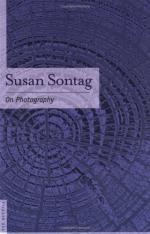
|
| Name: _________________________ | Period: ___________________ |
This test consists of 15 multiple choice questions and 5 short answer questions.
Multiple Choice Questions
1. The Chinese government denounced Antonioni's film as anti-Chinese and anti-___________.
(a) Artistic.
(b) Democratic.
(c) Pornography.
(d) Communist.
2. Who invited Antonioni to make a film about the Chinese life and its culture?
(a) Chinese government.
(b) United States government.
(c) Italian government.
(d) No one.
3. Collecting photographs is easy. What is NOT one of the reasons for the ease of collecting photographs, according to this chapter?
(a) They are easily transportable.
(b) They are durable.
(c) They can be stored on a computer.
(d) They are small.
4. And others believe that all proficient photographers must metaphysically ________ the object which they are photographing.
(a) Understand.
(b) Become.
(c) Connect with.
(d) Link to.
5. Both painting and photography share a devotion to traditional __________ within their finished pieces.
(a) Books.
(b) Subjects.
(c) Drama.
(d) Audiences.
6. By __________, photography became an acceptable part of modern day life, according to the book.
(a) 1800.
(b) 1828.
(c) 1854.
(d) 1839.
7. In later times, photography came to be viewed as an art, then as a high art, and today it is esteemed as a modern __________.
(a) High art.
(b) Rich art.
(c) Travesty.
(d) Young art.
8. Even banal or vapid objects can be made _____________ by being photographed, according to this chapter.
(a) Beautiful.
(b) Honest.
(c) Understood.
(d) Truthful.
9. "_______- proud hosts may well pull out photographs of the place to show visitors how really splendid it is."
(a) Family.
(b) Wealth.
(c) Baby.
(d) School.
10. How do beautiful things begin to seem cliched and dull? Through their ____________, things become cliched.
(a) Subjects.
(b) Colors.
(c) Over exposure.
(d) Repetition.
11. "Despite the efforts of contemporary photographers to exorcise the _____________, something lingers."
(a) Demons.
(b) Ordinary.
(c) Abstract.
(d) Specter of art.
12. Although one cannot possess all of _____________, one can possess images.
(a) Reality.
(b) Truth.
(c) Honesty.
(d) The family.
13. What is the question plaguing most photographic theory of the 1970s, according to Sontag in this chapter?
(a) Is photography art?
(b) Does the subject exist?
(c) Does art matter?
(d) How is photography real?
14. Many tribes view the act of taking pictures of something or of someone as ______________.
(a) Truthful.
(b) Evil.
(c) Soul stealing.
(d) Unnecessary.
15. Some champion total self ____________ for the photographer in order to capture subjects in the way that makes sense for an audience.
(a) Understanding.
(b) Effacement.
(c) Control.
(d) Aggrandizement.
Short Answer Questions
1. In 1839, photography was briefly attacked as something ___________ and disgraceful, according to the book.
2. In the conventional wisdom right now, only beautiful things are ______________.
3. What is NOT one of the things that the Chinese expect from photography, which can cause a disconnect?
4. Photographs cannot ___________ of something and are therefore obviously reproductive or mimetic.
5. Who was rendered with Antonioni's typical flair and technique, featuring long shots, close-ups, jarring juxtaposition, and a focus on the ordinary?
|
This section contains 435 words (approx. 2 pages at 300 words per page) |

|




